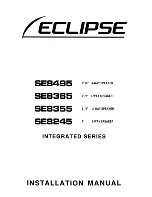
English
E-
7
6
SURROUND level control
This control is used for adjusting the sound level from
the surround speakers. Turn this control clockwise to
increase the level, and counterclockwise to decrease
the level.
7
SUBWOOFER level control
This control is used for adjusting the sound level from
the subwoofer. Turn this control clockwise to increase
the level, and counterclockwise to decrease the level.
8
MASTER VOLUME control
This control is used for adjusting the overall volume
level of this system. Turn this control clockwise to
increase the level, and counterclockwise to decrease
the level.
9
Headphone jack
Stereo headphones can be connected to this mini-jack
for private listening. Sound output from the speakers is
cut off when headphones are connected to this jack.
Sounds of all channels are mixed into 2 channels and
reproduced over the headphones.
0
Power indicator
Lights up when the power of this system is on.
A
Power switch
Each press of this switch changes the status of this
system between standby mode and power on. When
the power is on, the power indicator (
0
) lights up.
* Note that this system uses a small amount of power
in the standby mode.
B
SPEAKER OUTPUTS
FRONT:
Connect one satellite speaker with a 3 m cord to the L
terminal and another to the R terminal. They are used
as the front speakers.
SURROUND:
Connect one satellite speaker with a 7 m cord to the L
terminal and the other to the R terminal. They are used
as the surround speakers.
CENTER:
Connect one satellite speaker with a 3 m cord to this
terminal. It is used as the center speaker.
S. WOOFER:
Connect the subwoofer to this terminal.
C
SPEAKER MODE switch
Normally, set this switch to 5CH. According to your
preference, set this switch to another position.
5CH:
All speakers are used in this mode.
4CH:
Select this position when you will not use the center
speaker. In this mode, center sound is mixed and
outputted from the front L and R speakers.
2CH:
Select this position when you will not use the center
and surround speakers. In this mode, sounds of all
channels are mixed and reproduced from the front L
and R speakers as virtual surround sounds. [The
surround speakers reproduce the same sounds as the
front speakers (except for the test tone).]
D
DC IN connector
Connect the supplied AC adaptor to this connector.
E
DIGITAL INPUTS
External units with digital signal output terminals can
be connected to these terminals.
Input signals received at the OPTICAL terminal have
priority over the signals at the COAXIAL terminal.
OPTICAL:
Connect an external unit (a DVD/CD player, an MD
recorder, a video game player, etc.) with an optical
digital output terminal to this terminal by using the
supplied optical cable.
COAXIAL:
Connect an external unit (a DVD/CD player, an MD
recorder, a video game player, etc.) with a coaxial
digital output terminal to this terminal by using the
supplied RCA pin-plug cable.
F
ANALOG INPUTS
Connect the analog signal output terminals of an
external unit to these mini-jack terminals by using the
supplied mini plug cables or commercially available
pin-to-mini plug cables.
FRONT:
Connect the analog (stereo) signal output terminal of
an external unit to this terminal by using the supplied
mini plug cable. When you connect a sound board on a
computer which has 4-channel output terminals,
connect the front channel output terminal of the sound
board to this terminal.
SURROUND:
When you connect a sound board on a computer which
has 4-channel output terminals, connect the rear
channel output terminal of the sound board to this
terminal.










































